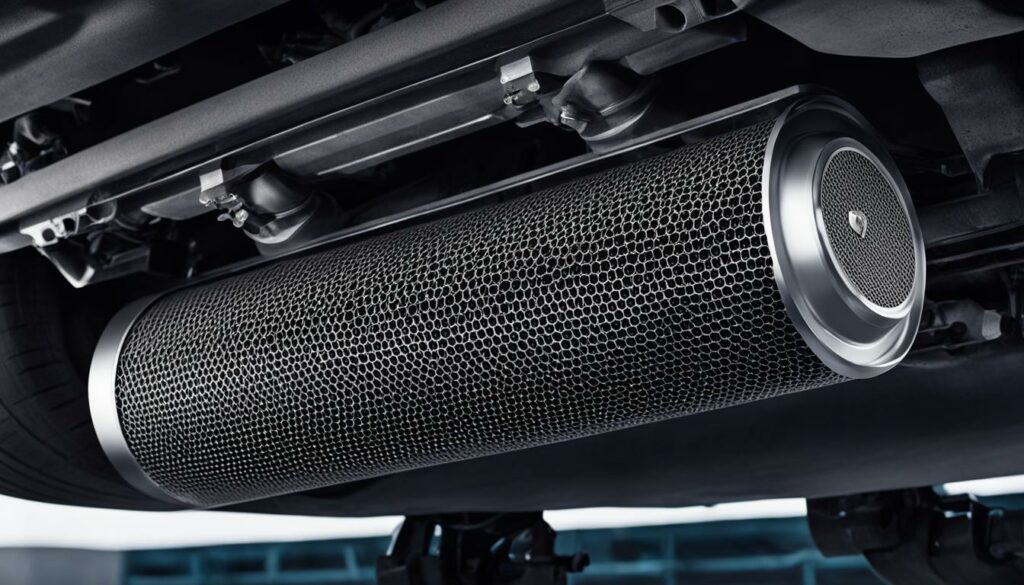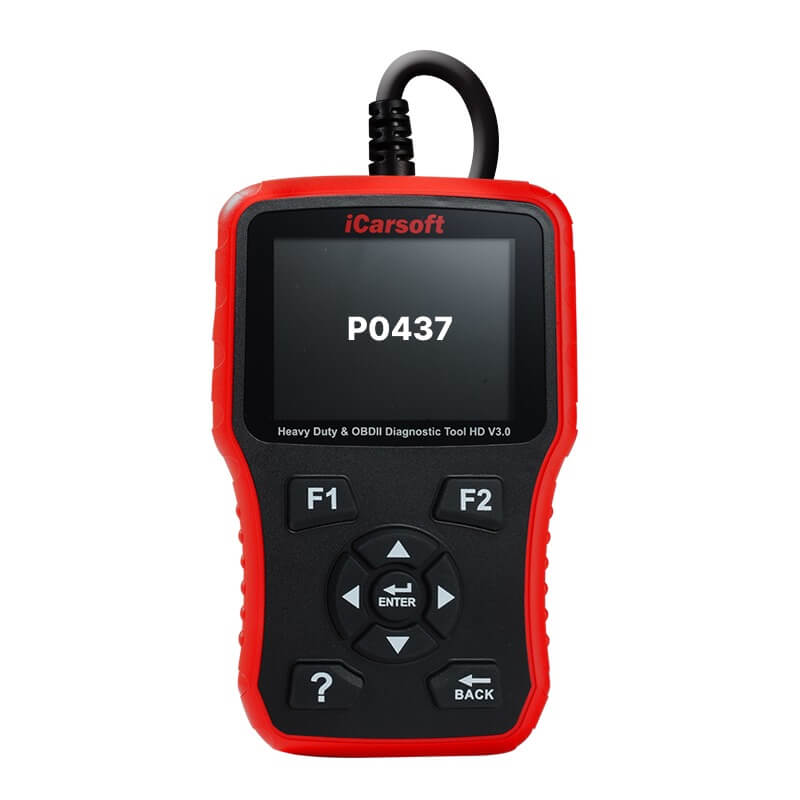P0437 – Catalyst Temperature Sensor Low Bank 2
POSTED IN pcodes
Welcome to our article on the P0437 code: Catalyst Temperature Sensor Low Bank 2. If you’ve encountered car trouble codes and are experiencing sensor malfunctions, this guide is for you. The P0437 code is a generic powertrain code that can be found in various makes and models of vehicles. It specifically relates to a low catalyst temperature sensor signal in bank 2 of the engine.
The catalytic converter is a vital component responsible for reducing harmful emissions by converting them into harmless water and carbon dioxide. Oxygen sensors monitor the efficiency of the catalytic converter, and a low temperature sensor signal suggests potential problems with the converter or the sensor itself.
Buy tested tuning file for Adblue / EGR / DPF / Adblue off now!
To help you understand and address this code effectively, we have compiled a detailed guide with technical descriptions, code severity and symptoms, common causes, diagnostic and repair procedures, and related DTC discussions. Additionally, we will provide insights into the necessary parts and solutions, as well as key takeaways for troubleshooting and resolving the P0437 code.
Key Takeaways:
- The P0437 code indicates a low catalyst temperature sensor signal in bank 2 of the engine.
- The code is specific to OBD-II equipped vehicles with a catalyst temperature sensor.
- Addressing the code is crucial as it can affect engine performance, fuel economy, and emissions.
- Possible causes include faulty oxygen sensors, wiring issues, and an imbalanced air/fuel mixture.
- Diagnostic procedures involve visual inspection, checking for other DTCs, and sensor testing.
Technical Description of P0437 Code
The P0437 code is a diagnostic trouble code that indicates a low catalyst temperature sensor signal in bank 2 of the engine. This code is specific to OBD-II equipped vehicles that have a catalyst temperature sensor. The sensor is responsible for monitoring the efficiency of the catalytic converter by measuring the temperature. The powertrain control module (PCM) compares the signals from the oxygen sensors to determine if the catalytic converter is operating properly. If the temperature sensor signal is too low, it suggests that the circuit is shorted.
| Technical Description | |
|---|---|
| Diagnostic Trouble Code | P0437 |
| Code Definition | Low catalyst temperature sensor signal in bank 2 of the engine |
| Vehicle Compatibility | OBD-II equipped vehicles with a catalyst temperature sensor |
| Sensor Function | Monitors the efficiency of the catalytic converter by measuring the temperature |
| PCM Comparison | Compares signals from the oxygen sensors to determine proper catalytic converter operation |
| Possible Cause | Circuit shorted |
Code Severity & Symptoms
The severity of the P0437 code is considered moderate. When this code is present, it can lead to various symptoms that can impact the performance and efficiency of the vehicle. It is crucial to address the code promptly to prevent further issues.
The symptoms associated with the P0437 code may include:
- An illuminated check engine light
- Poor engine performance
- Decreased fuel economy
- Increased emissions
If you notice any of these signs, it is recommended to take action and have your vehicle diagnosed to determine the exact cause of the code. Ignoring the symptoms can result in further damage to the engine and negatively affect the overall driving experience.
To gain a better understanding of the severity of the P0437 code and its impact, refer to the table below:
| Code Severity | Symptoms |
|---|---|
| Moderate |
|
As seen in the table above, the severity of the P0437 code is moderate, indicating that it requires attention. The symptoms of this code, such as an illuminated check engine light, poor engine performance, decreased fuel economy, and increased emissions, serve as warning signs that there may be an issue with your vehicle’s catalytic converter or temperature sensor.
Common Causes of P0437 Code
When diagnosing the P0437 code, it is essential to identify the common causes that may trigger this issue. These causes include:
- A faulty oxygen sensor: The oxygen sensor plays a crucial role in monitoring the exhaust gases and ensuring an optimal air/fuel mixture. If the oxygen sensor malfunctions, it can send inaccurate data to the engine control unit (ECU), causing the P0437 code to appear.
- Wiring problems: Damaged or loose wiring connections can disrupt the communication between the oxygen sensor and the ECU. This can result in an incorrect temperature sensor signal, leading to the P0437 code.
- An out-of-balance exhaust air/fuel mixture: A properly balanced air/fuel mixture is crucial for the efficient functioning of the catalytic converter. If there is an imbalance, such as a rich or lean mixture, it can trigger the P0437 code.
- A faulty PCM or PCM programming: The PCM is responsible for controlling various engine functions, including the operation of the catalytic converter. If the PCM is faulty or its programming is incorrect, it can generate the P0437 code.
It is important to address these common causes during the diagnosis process to accurately identify the underlying issue and perform the necessary repairs or replacements.
Diagnostic and Repair Procedures for P0437 Code
When encountering the P0437 code, it is crucial to follow the appropriate diagnostic and repair procedures to effectively address the issue. The following steps outline the recommended steps:
- Perform a Visual Inspection: Start by visually inspecting the upstream oxygen sensor and its corresponding wiring. Look for any visible damage, loose connections, or signs of corrosion. Rectify any identified issues before proceeding.
- Check for Other DTCs: It is important to check for other diagnostic trouble codes (DTCs) that could potentially affect the oxygen sensor readings. Use a scan tool to identify and resolve any additional codes.
- Test the Sensor Operation: Use a reliable scan tool to test the sensor operation. This will help determine if the sensor is functioning properly. Follow the manufacturer’s instructions on how to perform this test.
- Check the Circuit Continuity: Verify the continuity of the circuit between the sensor and the powertrain control module (PCM). Make sure there are no breaks or faults in the wiring. Repair or replace any damaged or faulty wires as needed.
- Test the Ground Side of the Circuit: Test the ground side of the circuit to ensure that it is working correctly. This can be done using a suitable multimeter. Troubleshoot and repair any grounding issues that may arise.
If none of the above steps resolve the issue, it may be necessary to reprogram or replace the PCM. Consult with a professional mechanic or dealership for further diagnosis and repair.
It is important to note that these diagnostic and repair procedures are general guidelines and may vary depending on the specific vehicle make and model. Always refer to the appropriate service manual or consult with a qualified technician for accurate procedures.

Related DTC Discussions
When encountering the P0437 code, it’s helpful to consider related diagnostic trouble codes (DTCs) such as P0435, P0436, and P0438. These codes are associated with the catalyst temperature sensor circuit and can provide additional insights into potential causes and solutions for a low catalyst temperature sensor signal in bank 2.
P0435: Catalyst Temperature Sensor Circuit Malfunction
The P0435 code indicates a malfunction in the catalyst temperature sensor circuit. This DTC suggests that there’s an issue with the circuit responsible for monitoring the catalytic converter’s temperature. It’s essential to address this code promptly to ensure the proper operation of the catalytic converter and optimal emissions control.
P0436: Catalyst Temperature Sensor Circuit Range/Performance
The P0436 code points to a range or performance issue with the catalyst temperature sensor circuit. This DTC signifies that the sensor’s signal is beyond the expected range or is not performing adequately. Investigating this code can aid in identifying the underlying problem affecting the temperature reading and catalytic converter functionality.
P0438: Catalyst Temperature Sensor Circuit High
The P0438 code indicates a high reading in the catalyst temperature sensor circuit. This DTC suggests that the sensor is detecting a temperature above the normal range, possibly due to a malfunction or fault in the circuit. It’s crucial to address this code promptly to prevent potential damage to the catalytic converter or other related components.
By exploring these related DTC discussions, you can gain a deeper understanding of the potential causes and solutions for a low catalyst temperature sensor signal in bank 2. This knowledge can aid in diagnosing the root issue and implementing effective repairs to restore the proper operation of the system.
Continue reading for further insights into the parts and solutions for addressing the P0437 code.
Parts and Solutions for P0437 Code
There are various parts and solutions that can help address the P0437 code. The specific part needed and the solution will depend on the diagnosis and the underlying cause of the low temperature sensor signal. Here are some common options:
1. Catalytic Converter Replacement

One possible solution is to replace a faulty catalytic converter. The catalytic converter plays a critical role in reducing emissions by converting harmful gases into harmless compounds. If the catalytic converter is not functioning properly, it can trigger the P0437 code. Replacing the catalytic converter with a new one can help resolve the issue and restore optimal performance.
2. Thermocouple Kit Installation
Another solution is to install a thermocouple kit. The thermocouple kit measures the temperature of the catalytic converter and provides accurate readings to the engine control unit (ECU). If the temperature sensor signal is too low, it could indicate a faulty thermocouple or a problem with the wiring. Installing a new thermocouple kit can help ensure accurate temperature readings and prevent the P0437 code from recurring.
3. Oxygen Sensor Replacement
In some cases, a faulty oxygen sensor can cause the low catalyst temperature sensor signal. The oxygen sensor is responsible for measuring the oxygen content in the exhaust gases and providing feedback to the ECU. If the oxygen sensor is malfunctioning, it can affect the overall operation of the catalytic converter. Replacing the faulty oxygen sensor with a new one can effectively address the P0437 code.
4. ECU Programming
“ECU programming is an advanced solution for resolving the P0437 code. It involves reprogramming the engine control unit to optimize the performance of the catalytic converter and ensure accurate temperature readings. This solution should be performed by a professional technician or a dealer with the necessary equipment and expertise.”
By reprogramming the ECU, it is possible to recalibrate the parameters and settings related to the catalytic converter, ensuring that it operates optimally and providing accurate temperature readings. ECU programming can be a viable solution for addressing the P0437 code and preventing its recurrence.
It is important to note that the specific part or solution required may vary depending on the make, model, and year of the vehicle. Consulting a professional technician or referring to the vehicle’s service manual is advisable to determine the most appropriate course of action.
Conclusion
Troubleshooting and fixing the P0437 code requires proper diagnosis and repair procedures. It is essential to address common causes such as faulty oxygen sensors, wiring problems, and an out-of-balance exhaust air/fuel mixture to resolve the issue effectively. If professional assistance is unavailable, there is an alternative solution available. Upload the Engine Control Unit (ECU) file to a dedicated portal for the permanent removal of the Pcode. Regular maintenance and proactive monitoring of the catalytic converter and related components can help prevent the occurrence of the P0437 code, ensuring optimal performance and efficiency for your vehicle. Remember, addressing code-related issues promptly will contribute to the longevity and reliability of your car’s engine.
FAQ
What does the P0437 code mean?
The P0437 code refers to a low catalyst temperature sensor signal in bank 2 of the engine. It indicates a potential problem with the catalytic converter or the sensor itself.
What is the severity of the P0437 code and what are the symptoms?
The severity of the P0437 code is considered moderate. Symptoms may include an illuminated check engine light, poor engine performance, decreased fuel economy, and increased emissions.
What are the common causes of the P0437 code?
Common causes of the P0437 code include a faulty oxygen sensor, wiring problems, an out-of-balance exhaust air/fuel mixture, and a faulty PCM or PCM programming.
What are the diagnostic and repair procedures for the P0437 code?
Diagnostic procedures include visually inspecting the upstream oxygen sensor and corresponding wiring, checking for other DTCs, and using a scan tool to test the sensor operation. Repair procedures may involve reprogramming or replacing the PCM.
Are there any related diagnostic trouble codes (DTCs) to the P0437 code?
Yes, related DTCs include P0435 (Catalyst Temperature Sensor Circuit Malfunction), P0436 (Catalyst Temperature Sensor Circuit Range/Performance), and P0438 (Catalyst Temperature Sensor Circuit High).
What are the parts and solutions for the P0437 code?
The parts and solutions for the P0437 code may include replacing a faulty catalytic converter, thermocouple kit, or oxygen sensor, depending on the diagnosis and underlying cause.
What is the recommended solution for troubleshooting and fixing the P0437 code?
Troubleshooting and fixing the P0437 code requires proper diagnosis and repair procedures. It is recommended to address common causes such as faulty oxygen sensors, wiring problems, and out-of-balance exhaust air/fuel mixture. Professional assistance may be necessary for an accurate diagnosis and repair.


